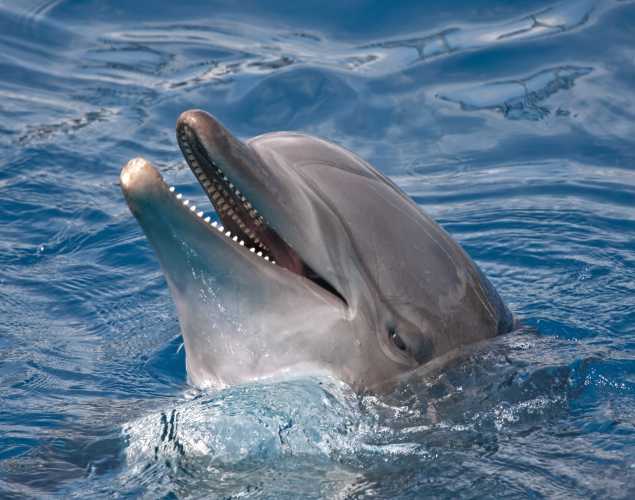
Epidemiology of Tattoo Skin Disease in Captive Common Bottlenose Dolphins
- Infectious disease
Abstract
Clinical and epidemiological features of tattoo skin disease (TSD) are reported for 257 common bottlenose dolphins held in 31 facilities in the Northern Hemisphere. Photographs and biological data of 146 females and 111 males were analyzed. Dolphins were classified into three age classes: 0-3 years, 4-8 years, and older than 9 years. From 2012 to 2014, 20.6% of the 257 dolphins showed clinical TSD. The youngest dolphins with tattoo lesions were 14 and 15 months old. TSD persisted from 4 to 65 months in 30 dolphins. Prevalence varied between facilities from 5.6% to 60%, possibly reflecting variation in environmental factors. Unlike in free-ranging Delphinidae, TSD prevalence was significantly higher in males (31.5%) than in females (12.3%). Infection was age-dependent only in females. Prevalence of very large tattoos was also higher in males (28.6%) than in females (11.1%). These data suggest that male T. truncatus are more vulnerable to TSD than females, possibly because of differences in immune response and susceptibility to captivity-related stress.
Van Bressem, M., Van Waerebeek, K., Duignan, P. J. 2018. Epidemiology of tattoo skin disease in captive common bottlenose dolphins (Tursiops truncatus): Are males more vulnerable than females? Journal of Applied Animal Welfare Science. 2018. DOI:10.1080/10888705.2017.1421076
Related Publications
{"image":"\/Animals\/Wild\/Other species\/nz-sea-lion-shutterstock.jpg","alt":"New Zealand sea lion","title":"Causes of Death in Two Populations of New Zealand Sea Lions","link_url":"https:\/\/www.marinemammalcenter.org\/publications\/causes-of-death-in-two-populations-of-new-zealand-sea-lions","label":"Research Paper"}

{"image":"\/Animals\/Patients\/California sea lions\/csl-by-bill-hunnewell-c-the-marine-mammal-center-6.jpg","alt":"California sea lions","title":"Zoonotic Bacteria Persistence and Susceptibility","link_url":"https:\/\/www.marinemammalcenter.org\/publications\/zoonotic-bacteria-persistence-and-susceptibility","label":"Research Paper"}

{"image":"\/Animals\/Patients\/California sea lions\/cropped-images\/csl-photo-by-bill-hunnewell-c-the-marine-mammal-center-1-0-0-2358-1722-1600891644.jpg","alt":"California sea lions","title":"Emerging Viruses in Marine Mammals","link_url":"https:\/\/www.marinemammalcenter.org\/publications\/emerging-viruses-in-marine-mammals","label":"Research Paper"}

{"image":"\/Animals\/Patients\/California sea lions\/csl-photo-by-bill-hunnewell-c-the-marine-mammal-center-12.jpg","alt":"two California sea lions","title":"Multi-Phase Muscle Breakdown in California Sea Lions","link_url":"https:\/\/www.marinemammalcenter.org\/publications\/multi-phase-muscle-breakdown-in-california-sea-lions","label":"Research Paper"}

Recent News
{"image":"\/Animals\/Patients\/Harbor seals\/2020\/cropped-images\/hs-barnwood-by-bill-hunnewell-c-the-marine-mammal-center-315-0-3299-2577-1607370547.jpg","alt":"harbor seal Barnwood","title":"Last-Minute Gift Guide \u2013 Top Gifts that Give Back to Marine Animals","link_url":"https:\/\/www.marinemammalcenter.org\/news\/last-minute-gift-guide","label":"News Update","date":"2025-12-18 01:00:00"}

Last-Minute Gift Guide – Top Gifts that Give Back to Marine Animals
December 18, 2025
Read More{"image":"\/Animals\/Patients\/Hawaiian monk seals\/2025\/cropped-images\/b-ru72admission-to-ke-kai-ola112125photo-c-the-marine-mammal-center-noaa-permit-24359-0-364-1270-992-1766095407.jpg","alt":"A newborn Hawaiian monk seal pup with a black coat in rehabilitative care.","title":"Newborn Hawaiian Monk Seal Pup Now Receiving Care","link_url":"https:\/\/www.marinemammalcenter.org\/news\/newborn-hawaiian-monk-seal-pup-now-receiving-care","label":"Patient Update","date":"2025-12-18 01:00:00"}

{"image":"\/Animals\/Patients\/Hawaiian monk seals\/2025\/cropped-images\/d-ru28release-exam-at-ke-kai-ola111025photo-by-giancarlo-rulli-c-the-marine-mammal-center-noaa-permit-24359-0-0-1270-992-1764620886.jpg","alt":"","title":"Bird Flu Vaccine Trial Offers Hope for Protecting Hawaiian Monk Seals","link_url":"https:\/\/www.marinemammalcenter.org\/news\/bird-flu-vaccine-trial-may-offer-hope-for-protecting-hawaiian-monk-seals","label":"News Update","date":"2025-12-01 08:13:00"}

Bird Flu Vaccine Trial Offers Hope for Protecting Hawaiian Monk Seals
December 1, 2025
Read More{"image":"\/Animals\/Patients\/Hawaiian monk seals\/2021\/hms-pp08-by-sheila-latta-c-the-marine-mammal-center-noaa-permit-18786.jpg","alt":"Hawaiian monk seal","title":"The New York Times: Inside the Bird-Flu Vaccine Trial for Monk Seals","link_url":"https:\/\/www.marinemammalcenter.org\/news\/the-new-york-times-inside-the-bird-flu-vaccine-trial-for-monk-seals","label":"In the News","date":"2025-12-01 01:00:00"}

The New York Times: Inside the Bird-Flu Vaccine Trial for Monk Seals
December 1, 2025
Read More
